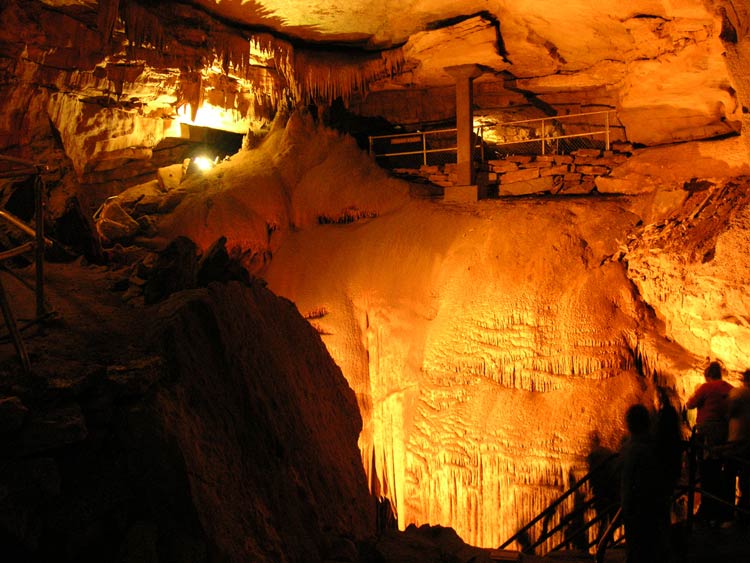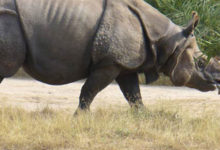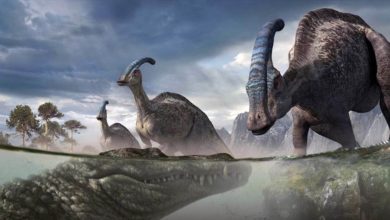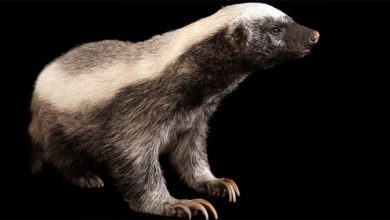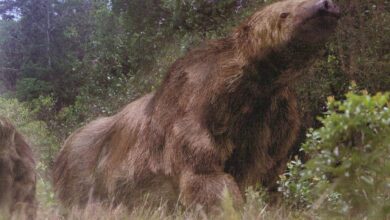Mammoth Cave National Park – Journey Beneath the Earth
Nestled deep within the rolling hills of Kentucky lies Mammoth Cave National Park, a place of ethereal beauty and geological wonder. With its labyrinth of twisting passageways and towering chambers, the park offers visitors a journey into the heart of the earth, revealing a world of breathtaking natural splendor and rich cultural history. Here, one can explore a seemingly endless network of caves, where ancient formations have been sculpted over millennia by the relentless flow of water, and where countless mysteries remain waiting to be uncovered. Whether you’re an avid hiker, a seasoned caver, or simply a lover of the great outdoors, Mammoth Cave National Park is an unforgettable destination that promises adventure, discovery, and inspiration.
Mammoth Cave National Park is a unique natural area located in central Kentucky, USA. It is a protected area that covers 52,830 acres (21,400 hectares) and contains the world’s longest-known cave system, with over 400 miles (640 km) of explored passageways. The caves are formed in a layer of limestone that was laid down over hundreds of millions of years and later exposed by the action of erosion. Over time, water has seeped through cracks in the rock and dissolved it, creating a maze of underground chambers and tunnels.
One of the most striking features of the caves is their size. Some of the chambers are over 100 feet (30 meters) tall, with ceilings that tower above visitors like the vaulted arches of a cathedral. The caves are also rich in unique formations, such as stalactites (icicles of rock that hang from the ceiling) and stalagmites (conical pillars of rock that rise from the floor), as well as other mineral deposits like flowstone and rimstone dams.
In addition to the caves, the park is also home to a diverse array of wildlife, including rare and endangered species like the Indiana bat, the gray bat, and the northern long-eared bat. There are also over 70 miles (112 km) of hiking trails, offering opportunities for visitors to explore the rolling hills and forests that surround the park.
Overall, Mammoth Cave National Park is a must-visit destination for anyone interested in geology, biology, or simply appreciating the beauty of nature. It offers a unique window into the earth’s history, as well as an unforgettable experience that is both educational and awe-inspiring.
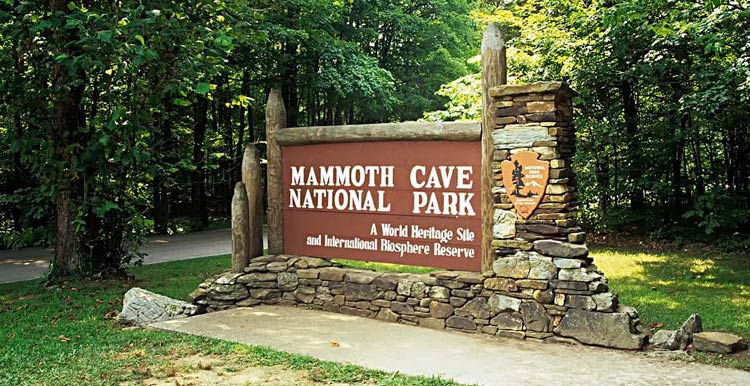
Location
Mammoth Cave National Park is located in central Kentucky, USA, near the small town of Mammoth Cave. It is approximately 90 miles (145 km) south of Louisville and 70 miles (112 km) north of Nashville. The park can be reached by car via several major highways, including I-65 and KY-70.
Basic Facts About Mammoth Cave National Park
- Area: The park covers an area of 52,830 acres / 21,400 hectares / 213.8 km2
- Cave System: It contains the world’s longest known cave system, with over 420 miles (680 km) of explored passageways.
- Geology: The caves are formed in a layer of limestone that was laid down over hundreds of millions of years and later exposed by the action of erosion.
- Wildlife: The park is home to a diverse array of wildlife, including rare and endangered species like the Indiana bat, the gray bat, and the northern long-eared bat.
- Hiking trails: There are over 70 miles (112 km) of hiking trails, offering opportunities for visitors to explore the rolling hills and forests that surround the park.
- Accessibility: The park can be reached by car via several major highways, including I-65 and KY-70.
- Designation: Mammoth Cave National Park was designated a National Park in 1941 and was designated a World Heritage Site by UNESCO in 1981.
History of the Park
The history of Mammoth Cave National Park is rich and varied, stretching back thousands of years to the first human inhabitants of the area. Here are some key events and milestones in the park’s history:
- Prehistory: Archaeological evidence suggests that Native American groups used the caves for shelter and religious rituals as far back as 4,000 years ago.
- European Settlement: In the late 1700s and early 1800s, European settlers began to explore the caves and extract saltpeter (a key ingredient in gunpowder) from them.
- Commercial Development: In the late 1800s, the caves became a popular tourist attraction, and several entrepreneurs developed them into a commercial operation, offering guided tours and souvenirs.
- National Park Designation: In 1941, President Franklin D. Roosevelt signed legislation establishing Mammoth Cave National Park, making it the country’s first national park dedicated to the preservation of a cave system.
- World Heritage Site: In 1981, Mammoth Cave National Park was designated a World Heritage Site by UNESCO, recognizing its importance as a geological and cultural resource.
- Scientific Research: Over the years, the park has been the site of numerous scientific studies, including research on the cave’s geology, hydrology, and biology, as well as its cultural and historical significance.
Today, Mammoth Cave National Park is a thriving natural area, attracting visitors from around the world and offering a wealth of opportunities for education, recreation, and discovery.
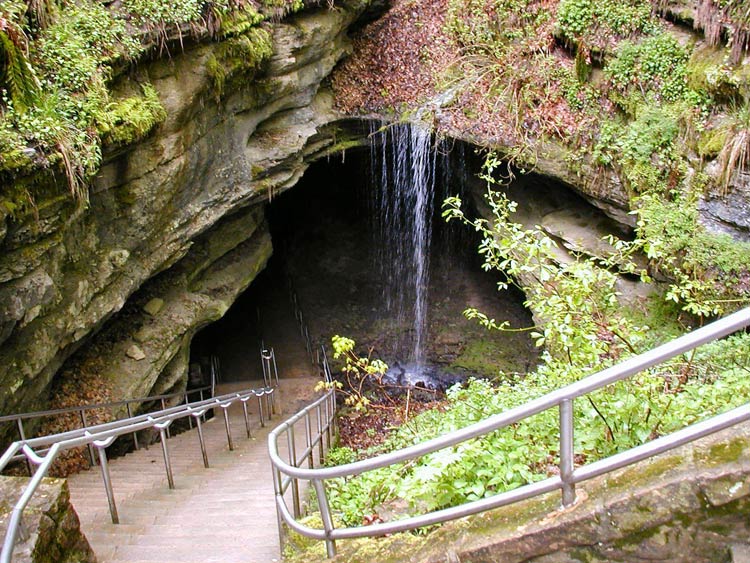
Name of the park
The name “Mammoth Cave” is believed to have originated from early European settlers who were impressed by the size of the caves and referred to them as “mammoth”. This term was used in the late 1700s and early 1800s, before the discovery of actual mammoths (an extinct species of elephant) in North America.
It is not known why the settlers chose this particular word to describe the caves, but some theories suggest that it may have been due to the large size of the passages and chambers, which seemed “mammoth” in comparison to other caves they had seen.
Regardless of its origins, the name “Mammoth Cave” has come to be associated with the park and is now widely recognized as one of the premier natural attractions in the United States.
Geography of the park
Mammoth Cave National Park is located in central Kentucky, USA, near the small town of Mammoth Cave. The park covers an area of 52,830 acres (21,400 hectares) and is situated on a plateau of rolling hills, surrounded by dense forest.
Geographically, the park is located within the Appalachian Mountains and is part of the Mammoth Cave Plateau, a large, elevated area of land that is characterized by rolling hills, forests, and numerous sinkholes and caves.
The caves themselves are formed in a layer of limestone that was laid down over hundreds of millions of years and later exposed by the action of erosion. The caves are part of an extensive karst system, which is a type of topography characterized by sinkholes, springs, and underground drainage.
The park’s location and geology have helped to shape its unique natural and cultural resources, including its world-famous cave system, diverse wildlife, and rich cultural heritage.
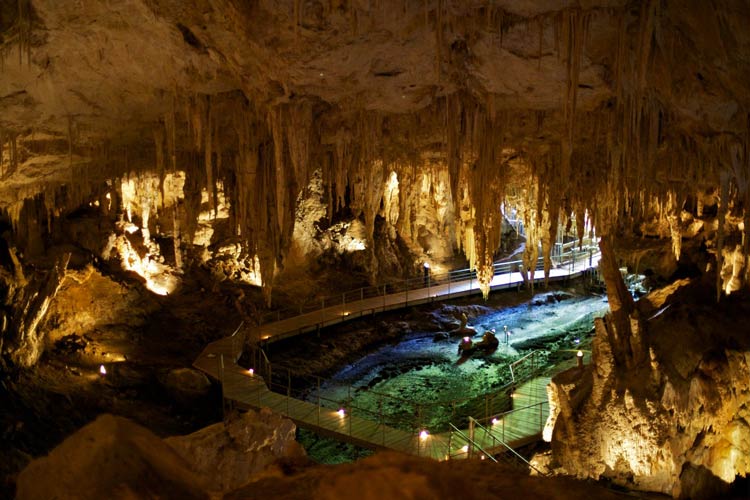
Features of the park
Mammoth Cave National Park is known for its extensive cave system, which is the main feature of the park and the reason for its designation as a national park. However, there are many other notable features of the park, including:
- Cave System: The park contains the world’s longest-known cave system, with over 400 miles (640 km) of explored passageways. Visitors can take guided tours of the caves, which offer opportunities to see unique geological formations, underground rivers, and rare species of bats and other animals.
- Hiking Trails: The park has over 70 miles (112 km) of hiking trails, offering visitors the opportunity to explore the rolling hills and forests that surround the caves. The trails range in difficulty from easy walks to strenuous backcountry hikes.
- Wildlife: The park is home to a diverse array of wildlife, including rare and endangered species like the Indiana bat, the gray bat, and the northern long-eared bat. In addition, visitors may see a variety of mammals, birds, reptiles, and amphibians while hiking or exploring the park.
- Picnic Areas: The park has several picnic areas, offering visitors a chance to enjoy a relaxing meal while taking in the beauty of the surrounding hills and forests.
- Historic Sites: The park has several historic sites, including the entrance to the cave used by saltpeter miners in the late 1700s and early 1800s, as well as the remains of a boarding house and hotel that served early visitors to the caves.
- Green River: The Green River flows through the park and provides opportunities for fishing, kayaking, and other water-based recreation.
- Campgrounds: The park has two campgrounds, offering visitors the chance to spend the night in the park and explore its many features and attractions.
These are just a few of the many notable features of Mammoth Cave National Park. Whether you’re interested in exploring the caves, hiking, wildlife-watching, or simply enjoying the beauty of the landscape, there is something for everyone at this unique and fascinating park.
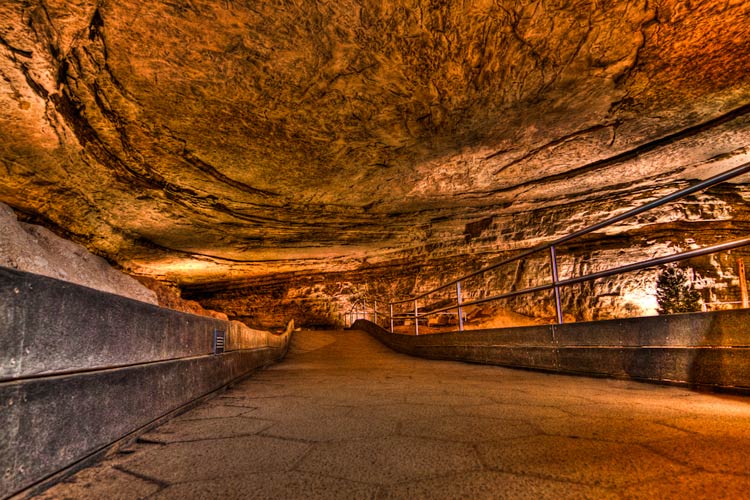
Geology of the park and surrounding areas
The geology of Mammoth Cave National Park and the surrounding area is dominated by a layer of limestone that was laid down over hundreds of millions of years. This layer of rock was later exposed by the action of erosion, creating a karst landscape characterized by sinkholes, springs, and underground drainage.
The caves themselves were formed by the action of water on the limestone, dissolving and enlarging existing cracks and crevices over millions of years. This process created a complex network of passages and chambers, some of which are over 200 feet (60 meters) tall and wide.
In addition to the limestone, the park and surrounding area contain other geological features, including sandstone cliffs, dolomite hills, and several large springs. These features, combined with the caves, offer a unique and fascinating window into the geologic history of the region.
The geology of the park and surrounding area has also played a significant role in shaping the local hydrology, wildlife, and cultural resources. For example, the caves provide a habitat for a variety of species that are adapted to live in the dark, damp underground environment. The springs that flow from the caves have long been used by humans for drinking water, irrigation, and other purposes.
The geology of Mammoth Cave National Park and the surrounding area is an important part of the park’s unique natural and cultural heritage, and continues to shape and influence the park today.
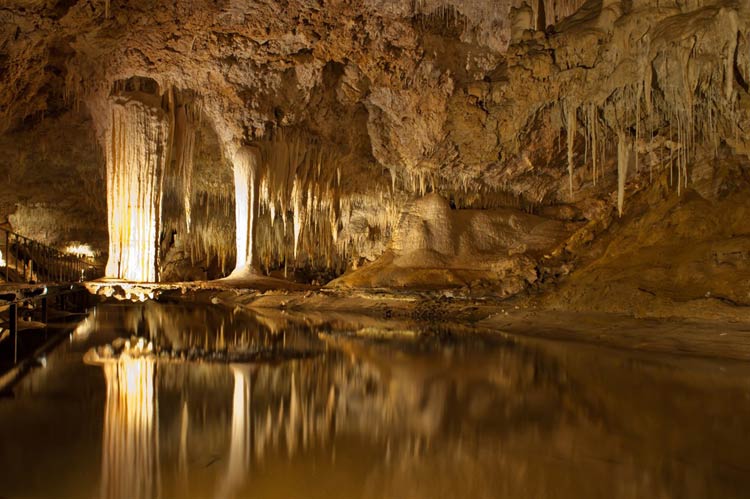
Climate of the park
Mammoth Cave National Park has a temperate climate, with four distinct seasons. Average temperatures in the park can range from -1°C (30°F) in the winter to 27°C (81°F) in the summer.
- Spring is characterized by warm, sunny days and cool, damp nights, with temperatures ranging from 10°C (50°F) to 21°C (70°F).
- Summer is hot and humid, with temperatures often exceeding 27°C (81°F) and frequent thunderstorms.
- Fall is a mild season, with cool, crisp days and chilly nights. Temperatures can range from 10°C (50°F) to 21°C (70°F).
- Winter is cool and dry, with temperatures ranging from -1°C (30°F) to 10°C (50°F). Snowfall is possible, but not common in the park.
It is important to note that temperatures in the caves themselves are relatively constant throughout the year, averaging around 10°C (50°F). Visitors to the caves should bring warm clothing, as the constant temperature can feel cooler in the winter and warmer in the summer than the outside air.
Flora in Mammoth Cave National Park
Mammoth Cave National Park is home to a diverse array of plant life, ranging from lush forests to rolling grasslands. Some of the notable plant species found in the park include:
- Eastern deciduous forest (Quercus, Acer, Fraxinus, Carya, Liriodendron)
- Oak-hickory forest (Quercus, Carya)
- Beech-maple forest (Fagus grandifolia, Acer saccharum)
- Bottomland hardwood forest (Acer rubrum, Fraxinus pennsylvanica)
- Grasslands (Andropogon gerardii, Schizachyrium scoparium)
- Wetlands (Phragmites australis, Typha latifolia)
In addition to these major vegetation types, the park also contains a number of rare and endangered plant species, including the running buffalo clover (Trifolium stoloniferum) and the swamp pink (Helonias bullata).
The park’s diverse plant life provides important habitat for a wide range of wildlife, and plays a critical role in maintaining the park’s ecological health and resilience.
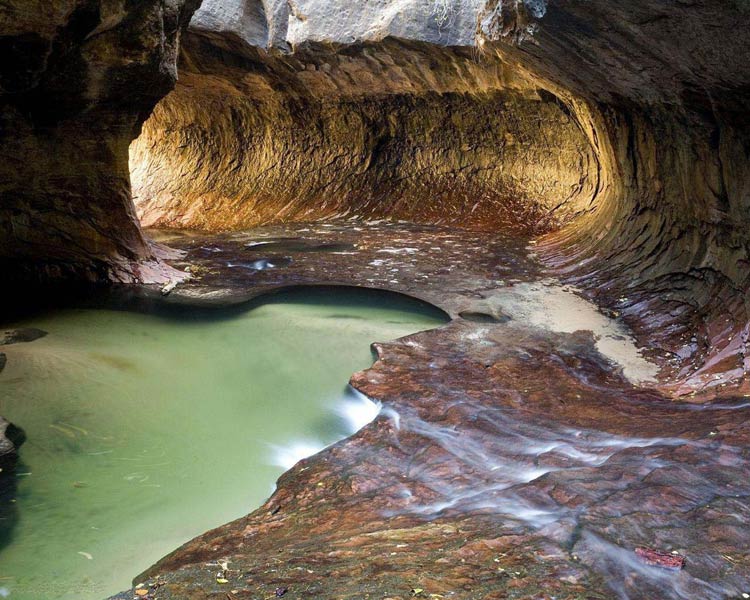
Fauna in Mammoth Cave National Park
Mammoth Cave National Park is home to a diverse array of wildlife, including a number of species that are unique to the region. Some of the notable animal species found in the park include:
- White-tailed deer (Odocoileus virginianus)
- Wild turkey (Meleagris gallopavo)
- Raccoon (Procyon lotor)
- Eastern gray squirrel (Sciurus carolinensis)
- Eastern chipmunk (Tamias striatus)
- Eastern cottontail (Sylvilagus floridanus)
- Eastern box turtle (Terrapene carolina carolina)
In addition to these common species, the park is also home to a number of rare and endangered animals, including the Indiana bat (Myotis sodalis), the gray bat (Myotis grisescens), and the Kentucky arrow darter (Etheostoma spilotum).
The caves themselves provide important habitat for a number of species that are adapted to life in the dark, damp underground environment, including cave salamanders (Gyrinophilus porphyriticus), cave crickets (Ceuthophilus secretus), and cave beetles (Leptodirus hochenwartii).
The park’s diverse wildlife provides important ecosystem services, and offers visitors the opportunity to observe and appreciate the beauty and complexity of nature
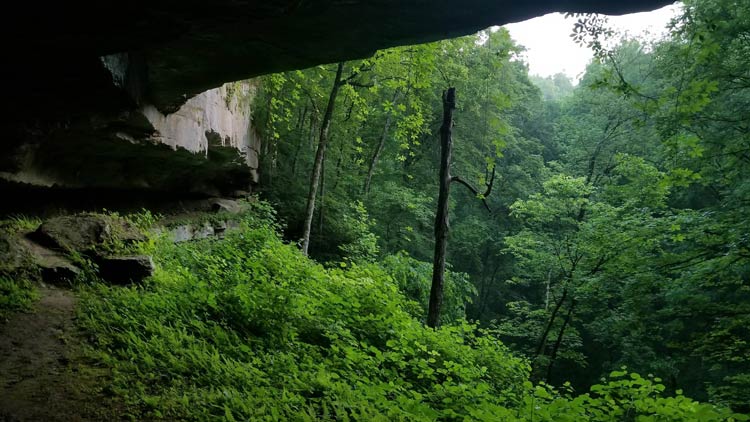
Tourism and tourist main attractions in the park
Mammoth Cave National Park is a popular tourist destination, attracting over half a million visitors annually. The park’s main attraction is, of course, the mammoth cave system, which is the longest-known cave system in the world. The park offers a variety of guided tours through the caves, ranging from short, easy walks to challenging, all-day expeditions. Some of the most popular tours include:
- The Historic Tour: A 1.5-hour (2.4 km) walk through the historic sections of the cave, including the iconic “Fat Man’s Misery” and “Rotunda” rooms.
- The New Entrance Tour: A 3-hour (4.8 km) tour that explores the newer sections of the cave, including the “Snowball Room” and “Bottomless Pit”.
- The Wild Cave Tour: A full-day (16 km) adventure that takes visitors off the beaten path and into the wild, undeveloped sections of the cave.
In addition to the cave tours, the park also offers a variety of outdoor activities, including hiking, camping, fishing, and horseback riding. The park’s hiking trails range from easy, scenic walks to challenging backcountry treks, and offer visitors the opportunity to explore the park’s diverse landscapes and wildlife.
Mammoth Cave National Park offers visitors a unique and unforgettable experience, showcasing the beauty and wonder of the natural world and the rich cultural history of the region.
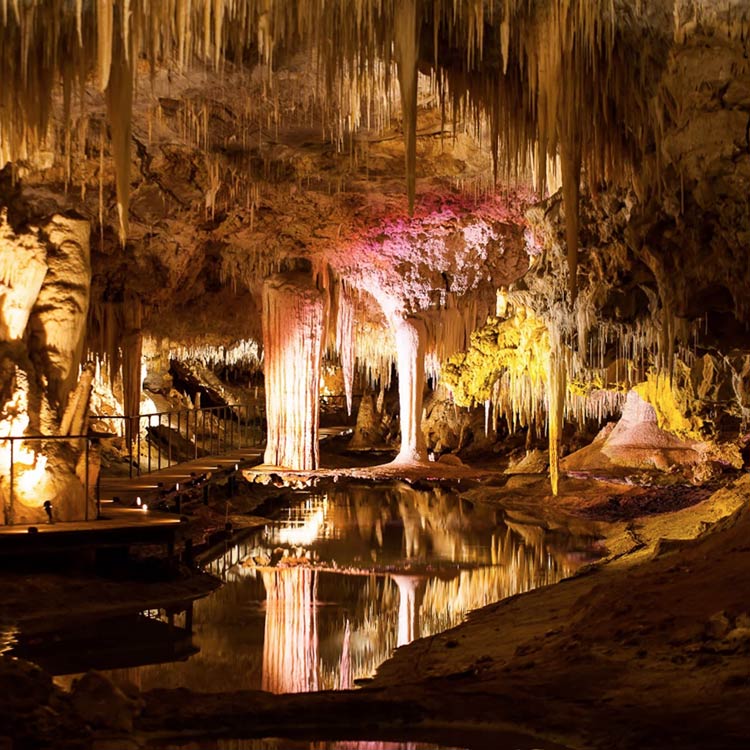
Cave Tours
Cave tours are one of the main attractions of Mammoth Cave National Park, allowing visitors to explore and experience the park’s extensive underground cave system. There are several different types of tours available, ranging from beginner-friendly walks to challenging and physically demanding adventures.
The most popular tour is the “Historic Tour,” which is a 2-hour walk that takes visitors through the park’s most famous caves and tunnels. This tour offers a glimpse into the rich cultural history of the cave, including its use by early settlers and its role as a source of saltpeter during the War of 1812.
For those looking for a more strenuous experience, the “Wild Cave Tour” is a 6-hour adventure that takes visitors off the beaten path and into some of the park’s less-explored areas. This tour involves crawling, climbing, and scrambling through narrow passages, and is recommended for experienced cavers and those in good physical condition.
In addition to these tours, there are several other options available, including a “Domes and Dripstones” tour, which showcases the cave’s unique geology, and a “Frozen Niagara” tour, which features a stunning display of frozen waterfalls and towering stalactites.
Regardless of the tour you choose, a visit to Mammoth Cave National Park is a unique and unforgettable experience, offering visitors the chance to explore one of the world’s most fascinating underground landscapes.
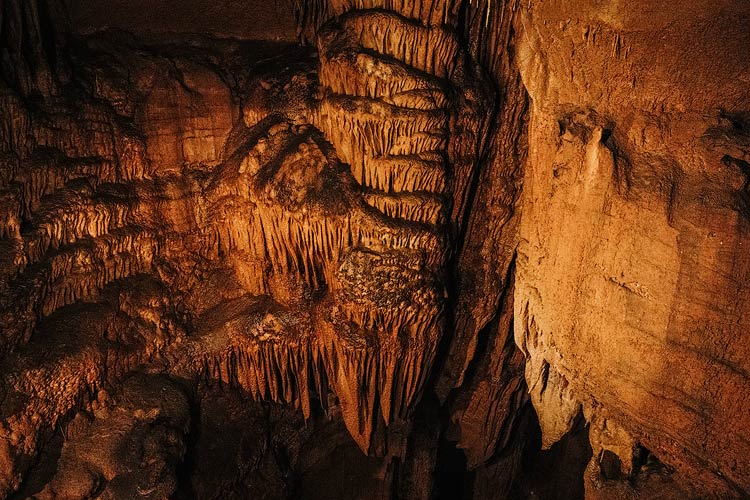
How To Reach To Mammoth Cave National Park?
Mammoth Cave National Park is located in central Kentucky, in the United States. There are several ways to reach the park:
- By Car: The park is accessible by car from several major highways, including I-65, I-71, and KY-255. Visitors can also reach the park by driving on local roads, including KY-70 and KY-715. There is a large parking lot near the park visitor center where visitors can park their cars.
- By Plane: The closest major airport to Mammoth Cave National Park is Louisville International Airport (SDF), which is approximately 80 km (50 mi) from the park. From there, visitors can rent a car or take a shuttle to reach the park.
- By Bus: The park is accessible by bus from several nearby cities, including Louisville, KY, and Nashville, TN. Visitors can take a public bus or a shuttle service to reach the park.
- By Train: There is no passenger train service directly to Mammoth Cave National Park. The closest Amtrak station is located in Louisville, KY, approximately 80 km (50 mi) from the park. From there, visitors can rent a car or take a shuttle to reach the park.
Regardless of the mode of transportation, visitors to Mammoth Cave National Park should be prepared for a scenic and beautiful journey, as the park is surrounded by rolling hills, lush forests, and sparkling rivers.
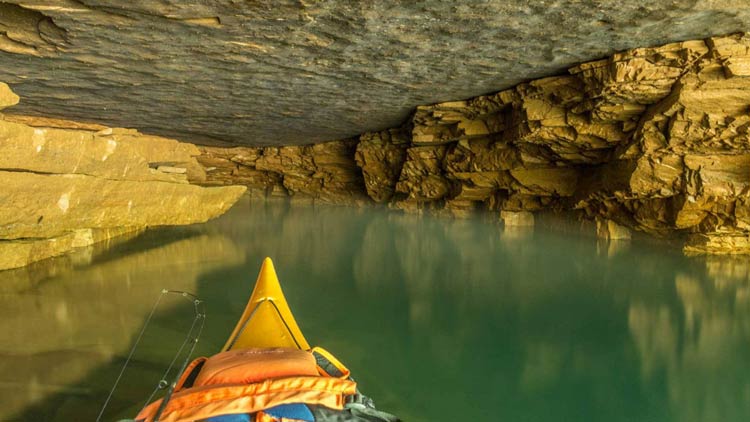
Best Time To Visit Mammoth Cave National Park
The best time to visit Mammoth Cave National Park depends on personal preference and the type of activities you plan to do during your visit. Generally, the park is open year-round, but some facilities and trails may be closed during the winter months due to inclement weather.
- Spring (March to May) is a popular time to visit the park, as the weather is mild and the landscape is lush and green. This is also a great time to see the park’s spring wildflowers, including bloodroot (Sanguinaria canadensis), trillium (Trillium spp.), and hepatica (Hepatica spp.).
- Summer (June to August) is a busy time at the park, as visitors flock to the park to enjoy the warm weather and participate in outdoor activities like hiking, camping, and fishing. Temperatures during this time of year can range from 20-30°C (68-86°F).
- Fall (September to November) is another popular time to visit the park, as the leaves of the park’s hardwood trees change color, creating a spectacular display of orange, yellow, and red. Temperatures during this time of year can range from 10-20°C (50-68°F).
- Winter (December to February) is the quietest time of year at the park, as many visitors are deterred by the cold weather and snow. Despite this, winter is a beautiful time to visit the park, as the landscape is blanketed in snow and the park’s many caves provide a warm and cozy refuge. Temperatures during this time of year can range from 0-10°C (32-50°F).
The best time to visit Mammoth Cave National Park depends on your personal preferences and the type of activities you plan to do. Whether you prefer mild spring weather or crisp winter days, there is something for everyone at this beautiful and unique national park.
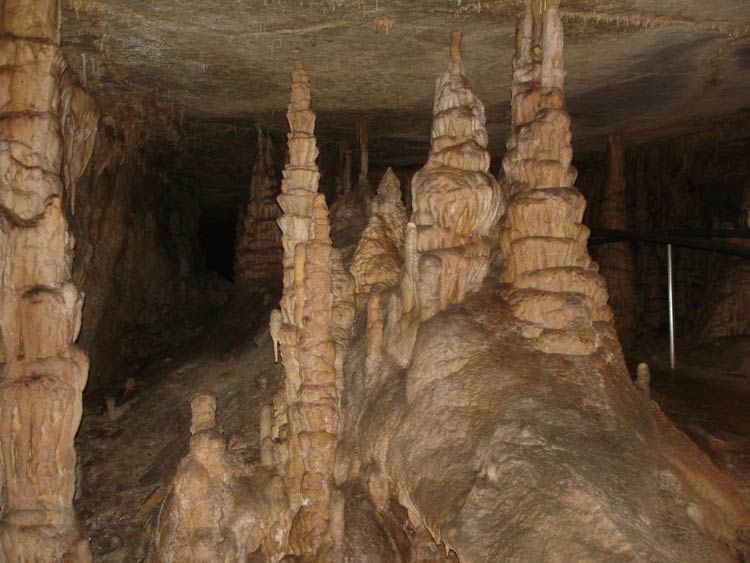
Conservation
Conservation is a major priority at Mammoth Cave National Park. The park is home to a diverse range of flora and fauna, including several species that are found nowhere else in the world. In order to protect and preserve this unique ecosystem, the park has implemented several conservation efforts, including habitat protection, species management, and invasive species control.
The park works closely with the U.S. Fish and Wildlife Service, the Kentucky Department of Fish and Wildlife, and other organizations to monitor and protect threatened and endangered species, such as the Indiana bat and the eastern hellbender salamander.
In addition to these species-specific efforts, the park also works to protect the overall health of the ecosystem by monitoring water quality, controlling non-native species, and managing human impacts such as pollution and overuse.
By promoting conservation and sustainable use of the park’s resources, Mammoth Cave National Park is working to ensure that future generations can enjoy and appreciate this unique and diverse ecosystem.
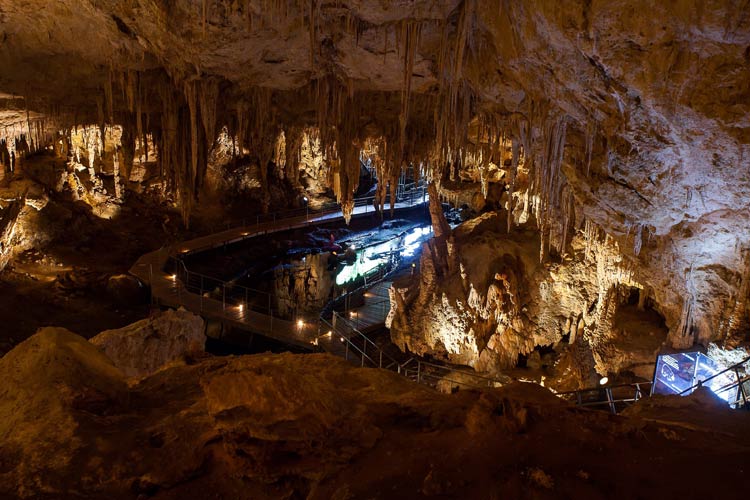
Mammoth Cave National Park in numbers
- Area: 52,830 acres / 21,400 hectares / 213.8 km2
- Visitors: 533,206 (in 2018)
- Designated as a national park: July 1, 1941
- Visitor center: The park has one main visitor center, located near the park’s entrance.
- Number of caves: Over 400 known caves, with approximately 367 km (228 mi) of passageways explored to date
- Length of the Mammoth Cave system: The Mammoth Cave system is the longest known cave system in the world, with over 643 km (400 mi) of explored passageways.
- Elevation: The park ranges in elevation from 144 m (472 ft) to 300 m (984 ft) above sea level.
- Average temperature: The average temperature in the park ranges from 10-20°C (50-68°F) in the summer to 0-10°C (32-50°F) in the winter.
- Annual precipitation: The park receives approximately 89 cm (35 in) of precipitation each year, with the majority of it falling as rain.
- Wildlife: The park is home to over 70 species of mammals, including white-tailed deer (Odocoileus virginianus), fox squirrels (Sciurus niger), and raccoons (Procyon lotor), as well as over 200 species of birds, including pileated woodpeckers (Dryocopus pileatus), Kentucky warblers (Geothlypis formosa), and great blue herons (Ardea herodias).
These numbers can help to provide a snapshot of the size, diversity, and beauty of Mammoth Cave National Park, one of the most unique and fascinating parks in the United States.
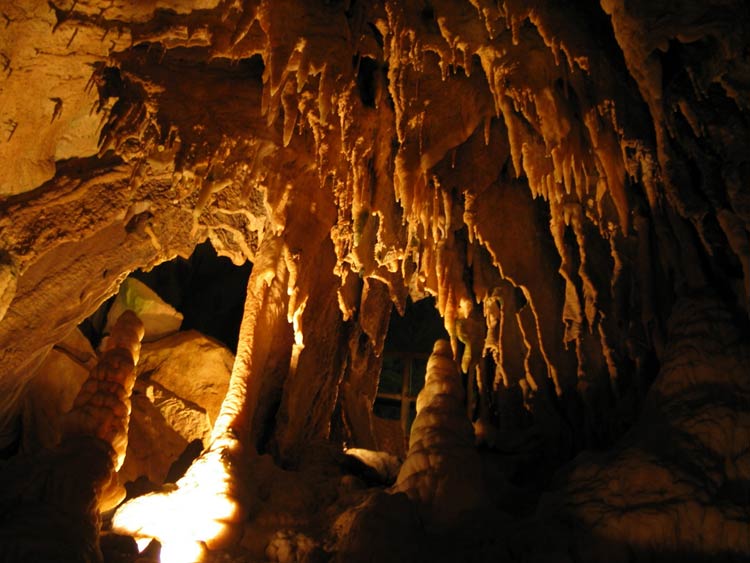
Interesting facts about Mammoth Cave National Park
- World Heritage Site: Mammoth Cave National Park was designated as a World Heritage Site by UNESCO in 1981.
- Longest Cave System: The Mammoth Cave system is the longest known cave system in the world, with over 643 km (400 mi) of explored passageways.
- Biodiversity: The park is home to over 70 species of mammals and over 200 species of birds, making it one of the most biodiverse parks in the United States.
- Endemic Species: The park is home to several species that are found nowhere else in the world, including the Kentucky cave shrimp (Palaemonias ganteri) and the grotto sculpin (Cottus sp.).
- Early Humans: Archaeologists have found evidence of human use of the caves dating back over 4,000 years.
- Underground River: The River Styx, which runs through the cave, is one of the few underground rivers in the world.
- Sustainable Tourism: The park is a leader in sustainable tourism, with a focus on reducing its impact on the environment and preserving the natural and cultural resources within the park.
- Cave Tours: The park offers a variety of cave tours, including easy, moderate, and strenuous options, allowing visitors to explore the caves at their own pace.
These fast facts help to highlight the unique and fascinating aspects of Mammoth Cave National Park, making it a must-visit destination for anyone interested in natural and cultural history.
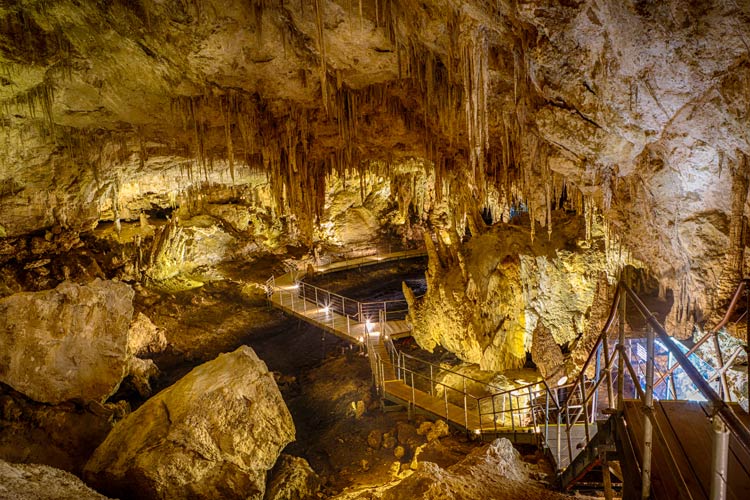
Q&A (questions and answers) about Mammoth Cave National Park
Q: What is Mammoth Cave National Park?
A: Mammoth Cave National Park is a national park located in central Kentucky, USA, that is known for its extensive cave system, which is the longest-known cave system in the world. The park covers an area of 52,830 acres (21,400 hectares) and is home to over 70 species of mammals and over 200 species of birds.
Q: When was Mammoth Cave National Park established?
A: Mammoth Cave National Park was established on July 1, 1941.
Q: What makes Mammoth Cave National Park unique?
A: Mammoth Cave National Park is unique for several reasons, including its extensive cave system, which is the longest-known cave system in the world, and its biodiverse ecosystem, which is home to over 70 species of mammals and over 200 species of birds. Additionally, the park is home to several species that are found nowhere else in the world, including the Kentucky cave shrimp and the grotto sculpin.
Q: What activities are available in Mammoth Cave National Park?
A: Mammoth Cave National Park offers a variety of activities, including cave tours, hiking, camping, fishing, and wildlife watching. The park also offers educational programs and events, including ranger-led tours, cave exploration workshops, and nature walks.
Q: Is Mammoth Cave National Park a World Heritage Site?
A: Yes, Mammoth Cave National Park was designated as a World Heritage Site by UNESCO in 1981.
Q: How can I reach Mammoth Cave National Park?
A: Mammoth Cave National Park is located in central Kentucky and is easily accessible by car. The nearest major city is Louisville, Kentucky, which is approximately 97 km (60 mi) from the park. The park is also accessible by public transportation, with a shuttle service available from the nearest major city, Louisville.
Q: When is the best time to visit Mammoth Cave National Park?
A: The best time to visit Mammoth Cave National Park is during the spring and fall months, when temperatures are mild and the weather is pleasant. Summer months can be hot and humid, while winter months can be cold and wet. The park is open year-round, and cave tours are available on a daily basis.
